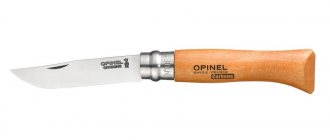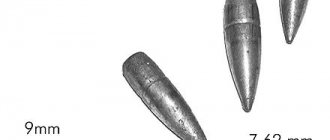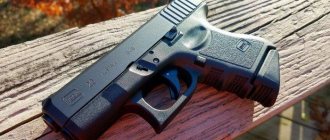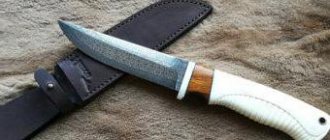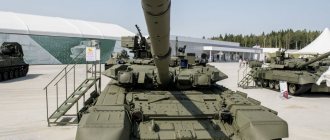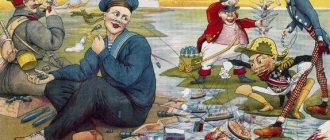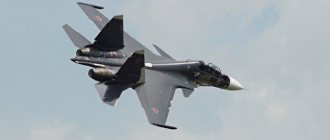This photo gallery shows bladed weapons used by Russian warriors of the 16th and 17th centuries. Its main disadvantage is that almost all of the presented samples are ceremonial and ceremonial. They were not intended for combat, but nevertheless give an idea of a military weapon. Russian weapons made by Russian craftsmen are similar in style to those of the East. This is especially true for bladed weapons (sabers and broadswords) and small arms (bow and quiver with a bow); a significant part of the weapons were purchased or received as trophies and gifts from the “busurman”.
At the same time, in the museums of Russia, Belarus and Ukraine there are many weapons of European and even Chinese style. But nevertheless: for Ukraine and Belarus this is due to the fact that they were under the rule of the Polish, German and Austrian empires, and therefore the style of weapons was appropriate. It is well known that the Ukrainian Cossacks, like the Russians, almost did not use armor, and used captured weapons, that is, eastern ones: sabers: klych (kilij) shemshir, Polish carabella (honor). The armament and equipment of the boyar cavalry, according to information from European ambassadors and travelers, was of the Turkish type. When regular troops appeared in the Moscow state, European foreign muskets, swords, helmets and cuirasses with leg guards began to be used.
Under False Dmitry the First, halberds began to be used little by little, but they never replaced the large axes that the Russians loved, the berdyshes. National features were visible in axes, maces, flails and spears.
Saadak
Saadak. Moscow. Weapons and cars, crowbar for a man. 1673 Master Prokofy Andreev. Materials: leather, silver, fabric, wood. Sewing: gilding, niello, carving. Beam length 72 cm; quiver length 41.5 cm
Made of leather and decorated with embroidery with silver and gold threads. The design of the saadak is extremely interesting, giving it special historical value. In the center, in the figured stamp, there is an image of a panorama of the Kremlin at the end of the 17th century, which was revealed to the viewer from Red Square: the Kremlin wall is surrounded by a deep ditch, through which bridges are thrown to the towers. Saadak is one of the few surviving monuments whose design depicts territorial emblems of the late 17th century. The central composition of the beam is surrounded by round stamps depicting the Novgorod, Kazan, Siberian, Pskov, Tver, Perm, Moscow, and on the quiver - also the Ryazan and Smolensk emblems, which later formed the basis for the city and regional coats of arms of these lands.
Saadak belonged to Tsar Alexei Mikhailovich.
aadak . Moscow. Weapons and cars, crowbar for a man. 1667 Masters: Prokofy Andreev and Ostafiy. Materials: leather, silver, fabric, wood. Sewing: gilding, niello, carving. The length of the bow is 75 cm, the length of the quiver is 44 cm.
Bow and arrows from the 19th century. Figures of griffins, pegasi, firebirds and other fantastic creatures are embroidered on green leather.
Ottoman – a cover for the bow and quiver. Belonged to Tsar Fyodor Alekseevich, second. half 17th century.
Case for the bow – 80 cm, case for the quiver – 60 cm. Italian silk, gold threads.
The historical epic of the Russian knife
As you know, the Russian Empire has long been famous throughout the world not only for red and black caviar, but also for its unsurpassed edged weapons. Hunting knives made in Russia were sought after not only in Europe, but also in America and Canada. In America, the Russian knife was tested in hand-to-hand combat, which was a kind of test for steel, blades and nerves. And every time the Russian knife took first place in these battles.
Most of these famous Russian knives were made in the Urals, in the small town of Zlatoust, which was completely lost among the mountains and forests. In 1815, Emperor Alexander I issued a decree according to which a weapons factory was to be organized in Zlatoust. It is curious that the first craftsmen at this factory were Germans. They truly turned out to be highly skilled artisans, persistent and hardworking, and their products were second to none.
Thanks to them, Russian craftsmen learned to weld the highest quality steel, grind and engrave products in the same way as was customary in the best factories in Europe. Thanks to the excellent work of the Ural Zlatoust factory, thousands of wonderful blades entered service with the Russian army and navy. With all this, I don’t at all want to say that before the Germans, Russian craftsmen did not know how to make high-quality weapons.
In the sixteenth century, magnificent masters of their craft worked in Moscow, in the armory. Their blades could be called real works of art, and sometimes one such weapon took many years to make: craftsmen carried out skillful cutting of steel, set the weapon in precious stones and gilded it. Naturally, such blades did not exist for army needs. Not only Moscow was famous for its weapons. Magnificent products were created in the Russian cities of Tula, Sestroretsk and Olonets.
In the Urals they learned to make steel no worse than ancient damask steel. The success of the new weapon was truly deafening, and the unique Russian damask steel began its victorious march across Europe. It was considered the best gift to present to a noble person a saber, dagger, hunting knife or broadsword made from Anosov damask steel. Everyone was proud of such a weapon, be it a nobleman, a military officer or a hunter. This was the heyday of Zlatoust art, when, thanks to unsurpassed masters, their own unique style of weapons was developed, and the tradition of quality was consolidated for centuries.
Of course, currently gunsmiths are trying to find their own style again, based on national and historically established types of Russian weapons. They have nothing to do with anything other than their children, and are busy with completely different interests, such as restoring antique styles of knives. They do not try to copy individual antique specimens, believing that each blade should be a unique product in its own way.
Such, for example, is the “Rus” knife - a typical example of an artistic weapon, the blade of which was made of Damascus steel. It was carved by the best gunsmith to date, V. Krivoshein. The very design of the knife and sheath were made by the famous Moscow master A. Georgiev, who has his own unique style in creating cold short-bladed weapons.
The blade of the “Rus” knife has a slight curve near the tip. The result is a knife that looks exceptionally graceful, especially thanks to the smooth direction of the highly curved handle. The dol has a wedge shape. It quickly narrows, coming to naught exactly where the blade begins to arch.
At the same time, the knife has high functional properties, despite its exquisite decorative effect. Thus, the handle of the knife is made of saiga horn. The natural curve is preserved, and the annular grooves seem to be specially adapted for the hand. On the heel of the blade there is the personal mark of the master: it is a bird with a cross on its head, which is reminiscent of traditional Christian symbolism.
Source: E. A. Ostanina “Combat knives of the world.”
Read on topic:
Flamberges - flaming blades
About sea dirks
The combat stiletto is a weapon of palace intrigue
What does a knife consist of?
What types of knives are there?
Sami knife as a historical heritage of the northern peoples
Finnish knife and its varieties
What is a hunting knife, its brief characteristics and features
Eastern traditional knives and Russia
Shilin's commander's knife
How the Opinel folding knife came about
Bowie knife is a universal weapon
Emerson Commander knife and its history
Types of throwing knives
Knife sheath and its placement
Chapter from the book by E. Ostanina “Legendary Knives of the World”
Knives are not edged weapons according to GOST
Important! Any characteristic that can be applied to a knife removes it from the category of edged weapon.
An object without a point;
The object has a tip located 5+mm above the butt line;
The tip is characteristically curved away from the cutting edge;
Blade up to 18 cm, with max. butt deflection is from 5 mm or butt deflection is more than 10 mm with a blade length of more than 18 cm;
If there is a sharpened hook on the butt of the knife for ripping open skins;
If the handle is in the form of a rocker arm, and the deflection of this butt does not exceed 15 mm from the top of this rocker arm;
The blade is shorter than 9 cm;
The blade and butt converge at an angle greater than 70°;
The blade is thicker than 5-6 mm.
Item without a sharpened blade. Steel training knives.
Knives that cannot be firmly held when stabbing cannot be classified as edged weapons.
- The handle is shorter than 7 cm;
- Barrel-shaped handle, with a difference in maximum and minimum diameters of less than 8 mm;
- An object whose total size of the limiter (guard) and protrusions for the finger is less than 5 mm;
- Items with a double-sided guard or two notches less than 4 mm;
Knives with blades that do not have the blade strength necessary for an injection are removed from edged weapons, namely:
- Blade steel with a hardness of less than 25HRC. Example: AK-74 bayonet;
- An object with a limiter or notch, blade length up to 150 mm and thinner than 2.5 mm;
- An object with so-called slotted blades;
- Item with non-steel blades: rubber, aluminum, plastic, silumin, wood. Training knives;
- Items in which the blade tang is not held in the handle, inserted loosely or filled with sealing wax.
Tula and Zlatoust knives
Two more long-famous centers. Tula products have recently looked dull, not striking in either quantity or quality, although there are a few good knives. It seems that they are made on an exclusive basis for representational purposes. Zlatoust - this product stands apart. Usually the Zlatoust knife is visible from afar. It sparkles brightly with polishing and gilded patterns, but... take it only with gloves. Things are more like jewelry than field items.
As you can see, in our country there are hunting knives for every taste, for every budget. Now the problem arises not where to get at least something, but what to choose from the many good and excellent knives.
Here you can give the following advice: first determine for what purpose you need a knife, this will outline the range of models. Then all that remains is to choose from this narrower circle the one that is affordable to you. And the most important opinion, on which the most inveterate debaters agree, is that there should be a lot of good knives!
Punishment for making, carrying, selling bladed weapons
In Russia, there are three main articles of the Criminal Code (CC) that relate to bladed weapons:
- Art. 222.4: Sales, that is, sale, of bladed weapons, is punishable by imprisonment for up to two years;
- Art. 223.4: Production and manufacture of bladed weapons, imprisonment for up to two years;
- Law on Weapons of the Russian Federation, Article 6. Carrying edged weapons, fine 2000 rubles with confiscation of weapons.
Most likely, there are many more laws and articles, there are probably a lot of by-laws and clarifications, but there is one fact, edged weapons cannot be produced, cannot be sold and cannot be carried. Or rather, an item recognized as a bladed weapon cannot be produced, sold or worn.
The final conclusion, whether the item is a bladed weapon or whether the knives are not bladed weapons, is made on the basis of an examination that is assigned for a specific case. But what to do and what to base it on when purchasing a knife or saber or other piercing and cutting object.
For such an assessment, there are state standards (list below) that regulate the production of knives and similar items that are not edged weapons.
Read on topic: What is airsoft?
Kizlyar knives
Once upon a time this word was just a sound. Now it is firmly associated with one of the largest knife-making centers in the country. A couple of large and up to a dozen small enterprises perform at specialized exhibitions under the banner of Kizlyar. The products produced are replicas of national weapons (checkers, daggers in the Caucasian style, bebuts), gift and souvenir knives, and quite good folding knives. Oddly enough, the reproaches for Kizlyar knives are the same as for Pavlovsk knives: unjustifiably pretentious design, not very artistic painting on the blade. It must be admitted that they also have successful models that are quite suitable for real work (in the sense of cutting sausage, planing wood, carrying in nature). I got the impression that on average the Kizlyar quality is slightly superior to the Vorsma-Pavlovian one, if one can even talk in such incomparable categories. The prices are also higher than we would like, but quite affordable. The St. Petersburg branch of Kizlyar stands out separately. As a rule, highly artistic exhibition items come out of it. It is clear that the prices cannot be called democratic. One more thing can be said about Kizlyar: according to conversations in knife circles, manufacturers respond quite quickly to the claims and wishes of customers, try to stay in the flow of international knife fashion, carry out marketing work more intelligently and dynamically, strive to improve quality, and develop new grades of steel. Although what is true for large teams cannot always be transferred to small firms.
